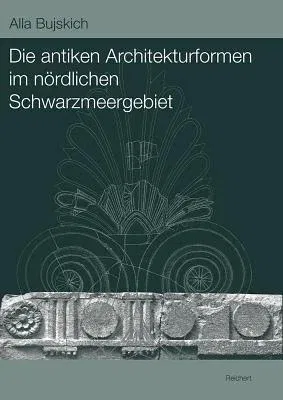Alla Bujskich
(Author)Die Antiken Architekturformen Im Nordlichen Schwarzmeergebiet: Herkunft Und EntwicklungHardcover, 25 April 2010


Description
English summary: This study is devoted to investigate the development of architectural orders in public and private architecture in the major Greek colonies in the northern part of the Black Sea area. Detailed analysis of architectural members lets us conclude that only one stylistic influence, mainly associated with the region of southern Ionia, affected the earliest pieces of Ionic order, and that this influence can be traced primarily to Miletus, the mother city of the first colonies in the North Pontus. Until the end of the Late Archaic period we are able to see a development of a local Ionic style in Olbia and the Bosporan region, especially also in Pantikapaion. The first public buildings with architectural decoration were represented by altars and temples. But during the 5th through 4th century B.C. different stylistic influences were effective: The north-western area was closely linked to Attica - local stone production of architectural details was dominated by Ionic and Doric orders under Attic influence. The north-eastern region, however, shows a strong influence of the Ionic order in Asia Minor, while the style in the Bosporan state, both the European and Asian parts, was shaped by public architecture at the capital, Pantikapaion. In the Hellenistic period, the development of monumental architecture using the different orders culminated in all regions of the North Pontus: Local architectural workshops flourished. It was the time when the third, the Corinthian order appeared, used mainly in small architectures as for example often in grave monuments, precincts and naiskoi. During the whole pre-Roman period, less than 10 percent of marble pieces were imported, mainly belonging to the Ionic and Corinthian orders.The appearance of the Romans in the region stopped the development of local architectural schools. Since then we find - in the 1st century A.D. - copies of Tuscan and Corinthian orders under the influence of Italian workshops, thus a western tradition. Later, from Hadrianic times until the end of the 3rd century, architectural decorations of public architecture depend on the style closely connected with the imperial marble trade: Import from Prokonnesos Island via the Black Sea was obviously preferred to local production, resulting in an amount of ca. 70 percent of imported marble decoration during the Imperial Period. As the main result of this study on architectural members in the North Pontic region we are able to incorporate this area into the general process of developing Greek architectural forms and thus reveal another aspect of the acculturation during the Greek colonization. German description: Thema des Buches ist die Entwicklung von Architekturordnungen in den bedeutendsten griechischen Kolonien des nordlichen Schwarzmeergebiets. Dabei werden sowohl die Bereiche der offentlichen als auch der privaten Architektur untersucht. Die genaue Analyse der Architekturglieder zeigt, dass die fruhesten Exemplare der ionischen Ordnung nur von einer stilistischen Richtung beeinflusst wurden. Diese wird hauptsachlich mit der Region von Sudionien und dort vor allem mit Milet, der Mutterstadt der ersten Kolonien am Nordpontos, verbunden. Bis zum Ende der spatarchaischen Zeit lasst sich die Entwicklung eines lokalen ionischen Stils in Olbia und in der bosporanischen Region, besonders auch in Pantikapaion, beobachten. Zu den ersten offentlichen Bauten mit Architekturornamentik gehoren Tempel und Altare. Im 5. bis 4. Jahrhundert v. Chr. treten jedoch verschiedene stilistische Einflusse auf: Die nordwestliche Region ist stark mit Attika verbunden - in der lokalen Steinproduktion werden vorherrschend architektonische Details der dorischen und ionischen Ordnung unter attischem Einfluss gefertigt. Die nordostliche Region entwickelt sich dagegen unter dem starken Einfluss der ionischen Ordnung Kleinasiens, wahrend die Ausbildung des Architekturstils im Bosporanischen Reich - sowohl im europaischen als auch im asiatischen Teil - von Vorbildern offentlicher Bauten der Hauptstadt Pantikapaion gepragt ist. In der hellenistischen Zeit erreicht die Verwendung der verschiedenen Architekturordnungen bei monumentalen Bauten in allen Regionen des Nordpontos ihren Hohepunkt, die lokalen Architekturwerkstatten florieren. In dieser Zeit wird nun auch die dritte, die korinthische Ordnung, aufgenommen. Diese wird hauptsachlich fur kleine Architekturformen genutzt, beispielsweise in Grabbauten, eingefriedeten Bezirken und kleinen Tempeln. In der gesamten vorromischen Zeit werden weniger als zehn Prozent der Marmorteile importiert, wobei diese hauptsachlich zur ionischen und korinthischen Ordnung gehoren. Das Auftreten der Romer in der Region beendet schliesslich die Entwicklung der lokalen Architekturschulen. Ab dieser Zeit, dem 1. Jahrhundert n. Chr., sind vor allem Imitationen der tuskanischen und korinthischen Ordnung unter dem Einfluss italischer Werkstatten zu verzeichnen. Von hadrianischer Zeit bis zum Ende des 3. Jahrhunderts n. Chr. ist die stilistische Entwicklung der Dekoration offentlicher Architektur dann eng mit dem kaiserlichen Marmorhandel verknupft: Der Import von Marmorteilen aus den Steinbruchen der Insel Prokonnesos uber das Schwarze Meer wird einer lokalen Herstellung vorgezogen. Folglich liegt der Anteil importierter Marmorteile in den ersten Jahrhunderten n. Chr. bei fast 70 Prozent. Als Hauptergebnis der Studie ist zu verzeichnen, dass nun auch die Region des nordlichen Schwarzmeergebiets in den allgemeinen Entwicklungsprozess griechischer Architekturformen eingebunden werden kann und damit ein weiterer Aspekt der Akkulturation wahrend der griechischen Kolonisation aufgezeigt wird.